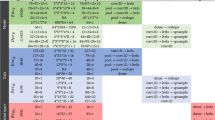Abstract
The objective of most formulations of inverse modeling in the Earth Sciences is to estimate the model parameters given the observation data. In this paper, an additional element to these formulations is considered, namely, the prediction for which the models are built. An example of such modeling is the prediction of solute transport using geological models of the subsurface constrained to existing geophysical, flow dynamic and solute observations. The paper then illustrates and addresses a fundamental question relating data, model and prediction: does model inversion reduce uncertainty in prediction variables given the observed data? To investigate this question, a diagnostic tool is proposed to assess whether matching the observed data significantly reduces uncertainty in the prediction variables. In addition, for some cases, a quick estimate of uncertainty can be obtained without applying inverse modeling. It relies on a dimensionality reduction method using non-linear principal component analysis (NLPCA) calibrated from evaluating the prediction and data response variables on a few prior Earth models. The proposed diagnostic tool is applied on a simple example of tracer flow and, for the cases investigated, the NLPCA provided an accurate diagnostic and a satisfactory pre-estimation of uncertainty in the prediction variables.















Similar content being viewed by others
References
Alcolea A, Renard P, Mariethoz G, Bertone F (2009) Reducing the impact of a desalination plant using stochastic modeling and optimization techniques. J Hydrol 365(3–4):275–288
Bayer P, Huggenberger P, Renard P (2011) Three-dimensional high resolution fluvio-glacial aquifer analog: part 1: field study. J Hydrol 40(5):1–9
Bishop C (1995) Neural Network for Pattern Recognition. Oxford University Press, New York
Bos CFM (2000) Production forecasting with uncertainty quantification. Final report of EC project, NITG-TNO report NITG 99–255-A
Borg I, Groenen P (1997) Modern multidimensional scaling: theory and applications. Springer, New York
Bowman AW, Azzalini A (1997) Applied smoothing techniques for data analysis. Oxford University Press, Oxford
Caers J, Srinivasan S et al (2002) Statistical pattern recognition and geostatistical data integration. In: Wong P (ed) Soft computing for reservoir characterization and modeling. Springer, New York, pp 355–386
Carrera J, Alcolea A, Medina A et al (2005) Inverse problem in hydrogeology. Hydrogeol J 13:206–222
Cherpeau N, Caumon G, Caers J, Levy B (2012) Method for stochastic inverse modeling of fault geometry and connectivity using flow data. Math Geosci 44(2):147–168
Comunian A, Renard P, Straubhaar J, Bayer P (2011) Three-dimensional high resolution fluvio-glacial aquifer analog—part 2: geostatistical modeling. J Hydrol 40(5):10–23
Ferraille M, Marel A (2012) Prediction under uncertainty on a mature field. Oil Gas Sci Technol 67:193–206
Freeze RA, Massmann J, Smith L, Sperling T, James B (1990) Hydrogeological decision analysis: 1. A framework. Ground Water 28:738–766
Gallagher M, Doherty J (2007) Predictive error analysis for a water resource management model. J Hydrol 334(3–4):513–533
Ginsbourger D, Rosspopoff B, Pirot G, Durrande N, Renard P (2013) Distance-based kriging relying on proxy simulations for inverse conditioning. Adv Water Res 52:275–291
Kramer MA (1991) Nonlinear principal component analysis using auto-associative neural networks. AIChE J 37:233–243
Künze R, Lunati I (2012) Adaptive multiscale simulations of density driven instabilities. J Comput Phys 231:5557–5570
Künze R, Lunati I (2011) MAFLOT: a matlab toolbox to simulate flow through porous media. Technical Report. University of Lausanne, Switzerland. http://www.maflot.com/
Metropolis N, Ulam S (1949) The Monte Carlo method. J Am Stat Assoc 44:335–341
Metropolis N, Rosenbluth AW, Rosenbluth MN et al (1953) Equations of state calculations by fast computing machines. J Chem Phys 21:1087–1091
Mosegaard K, Tarantola A (1995) Monte Carlo sampling of solutions to inverse problems. J Geophys Res 100(B7):12431–12447
Mosegaard K, Tarantola A (2002) Probabilistic approach to inverse problems. In: Lee W, Jennings P, Kisskinger C, Kanamori H (eds) International handbook of earthquake and engineering seismology, Part A. Academic Press, London, pp 237–265
Mugunthan P, Shoemaker CA (2006) Assessing the impacts of parameter uncertainty for computationally expensive groundwater models. Water Resour Res 42(W10428)
Oliver D, Chen Y (2011) Recent progress on reservoir history matching: a review. Comput Geosci 15: 185–221
Park H, Scheidt C, Fenwick DH et al (2013) History matching and uncertainty quantification of facies models with multiple geological interpretations. Comput Geosci 17:609–621
Ripley B (1987) Stochastic simulation. Wiley, New York
Schöelkopf B, Smola A (2002) Learning with kernels. MIT Press, Cambridge
Silverman BW (1986) Density estimation for statistics and data analysis. Chapman and Hall, London
Straubhaar J, Renard P, Mariethoz G et al (2011) An improved parallel multiple-point algorithm using a list approach. Math Geosci 43(3):305–328
Tavassoli Z, Carter JN, King PR (2004) Errors in history matching. SPE J 9(3):352–361
Zhou H, Gómez-Hernández JJ, Li L (2013) Inverse methods in hydrogeology: evolution and recent trends. Adv Water Res. doi:10.1016/j.advwatres.2013.10.014
Acknowledgments
The authors would like to acknowledge the Swiss National Science Foundation for financial support under the contract CRSI22 122249/1: Integrated methods for stochastic ensemble aquifer modeling (ENSEMBLE) project.
Author information
Authors and Affiliations
Corresponding author
Rights and permissions
About this article
Cite this article
Scheidt, C., Renard, P. & Caers, J. Prediction-Focused Subsurface Modeling: Investigating the Need for Accuracy in Flow-Based Inverse Modeling. Math Geosci 47, 173–191 (2015). https://doi.org/10.1007/s11004-014-9521-6
Received:
Accepted:
Published:
Issue Date:
DOI: https://doi.org/10.1007/s11004-014-9521-6




